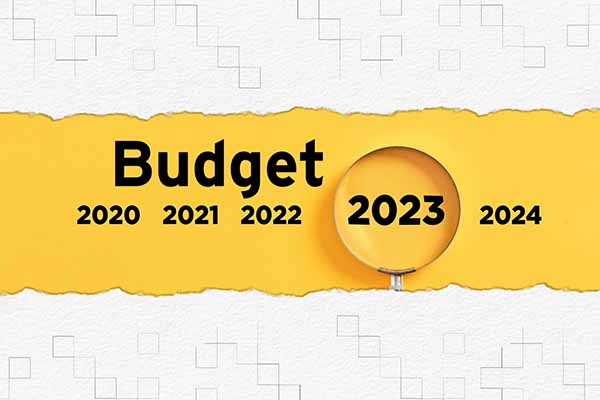Finance Minister Nirmala Sitharaman will present the Union Budget 2023-24 on 1st February. The government amends and updates policies and programs yearlong to tackle the issues at hand. The union budget sets the direction which government adopts in the short term and the long term. Industry and people look forward to union budget announcements with hope and expectations.
Government announcement in the union budget includes various schemes and budgetary allocations for various sectors.
Union Budget 2022-23:

In the union budget 2022-23, the government announcement for the electronics sector included:
- Calibrated customs duty rates to facilitate domestic manufacturing of products like wearables and electronic smart meters.
- Duty concessions were given to parts of transformers, mobile phone chargers, camera lenses of mobile camera modules and other such items and components.
- The announcement also included a design-led manufacturing endeavour to manufacture 5G equipment. This is to build a robust 5G ecosystem as part of the Production Linked Incentive (PLI) scheme.
Opportunities in 2022:
After 2 hiatus years of Covid-19, the year 2022 brought normalcy to the electronics sector in India. Smartphone shipments from India crossed the Rs 50,000-crore mark during April-November 2022. It is up 110% compared to the same period last year. Further, Vedanta and Foxconn announced an investment of 1.54 trillion rupees to set up a semiconductor project in Gujarat.
PM Modi launched 5G services in India on 1 October 2022, at the India Mobile Congress. With the launch of the 5G services, there will be further expansion in the IoT and 5G use cases. This will give further impetus to the development of the electronics sector in India. The automotive sector brought forward the advancement of ADAS technology to the Indian middle class with the launch of ADAS-capable mid-segment cars.
At the same time, this sector was crippled due shortage of semiconductor chips.
Expectations from Union Budget 2023-24:
Considering the above advancements and challenges, electronics industry associations in India want the government to shift its focus from the existing mindset of “manufacturing for import substitution” to “encourage manufacturing for exports.”

India Electronics and Semiconductor Association (IESA) suggests imposing import duty to encourage the manufacturing of electronic equipment in India. Vivek Tyagi, Chairperson, IESA says, “We, at IESA, intend to further boost local electronics manufacturing. Therefore, we suggest that the PLI scheme should be converted to a design-led manufacturing scheme or DPLI. We request the government to provide incentives if a company designs its electronics and manufactures locally as well. Imposing an import duty of 10% on any imported electronics equipment and assembled PCB will encourage local manufacturing to a great extent.”

Pankaj Mohindroo, Chairman, India Cellular and Electronics Association (ICEA) says, “The Indian ESDM industry needs a greater handholding in terms of support on account of duty concessions on inputs. The higher import duties on inputs used for the manufacture of electronic items increases the cost of manufactured products and makes them uncompetitive in the international markets.”
India’s electronics export is lower in comparison to the competing nations such as China, Vietnam, Malaysia, Thailand, etc. ICEA report has found that India has the highest tariff rates than the competing nations i.e, 9.7% as against 3.2 in China, 3.5% in Mexico, 5% in Thailand, 5.6% in Vietnam and so. The Indian ESDM industry is facing the heat and encountering difficulties in competing in the international markets.
Import Duty:
Some inputs used for the manufacture of mobile phones still attract import duties ranging from 2.75% to 11%. This makes India-made mobile phones costlier in the international market. These duties were imposed outside the structure of the Phased Manufacturing Programme (PMP).
Pankaj says, “This import duty is not refundable, not creditable, and leads to an absolute increase in the cost of manufacturing and product. Unfortunately, these inputs are not manufactured in India as per the required quality and consistency levels. This should be immediately waived to increase exports of mobile phones from India.”
Similar duty instances are observed in the manufacturing of Open cells for LED TVs wherein open cells attract an import duty of 5%. Further, their inputs are also at 5% thereby making the open cells in India be non-lucrative manufacturing option.
ICEA further expects the union budget to provide similar depreciation benefits under IGCR Rules to the capital goods used under the MOOWR scheme.
Skilling:

The government is committed to and has a clear vision for skill development. It is actively supporting the skill development of the youth through various policies and programs. Electronics Sector Skills Council of India (ESSCI) hopes that the government will maintain its policy of skill development and support for the electronics sector.
Dr. Abhilasha Gaur, COO, ESSCI says, “The increase in budgetary support for apprenticeship in the last budget was a good move. We hope the trend continues to ensure a larger number of apprentices engaged by the ESDM industries.”
ESSCI further expects the government to issue some form of guidance for the sector in the union budget. This is to encourage businesses to employ personnel who meet the requirements of the National Skill Qualification System. Therefore, ensuring a level playing field for industries and businesses.














